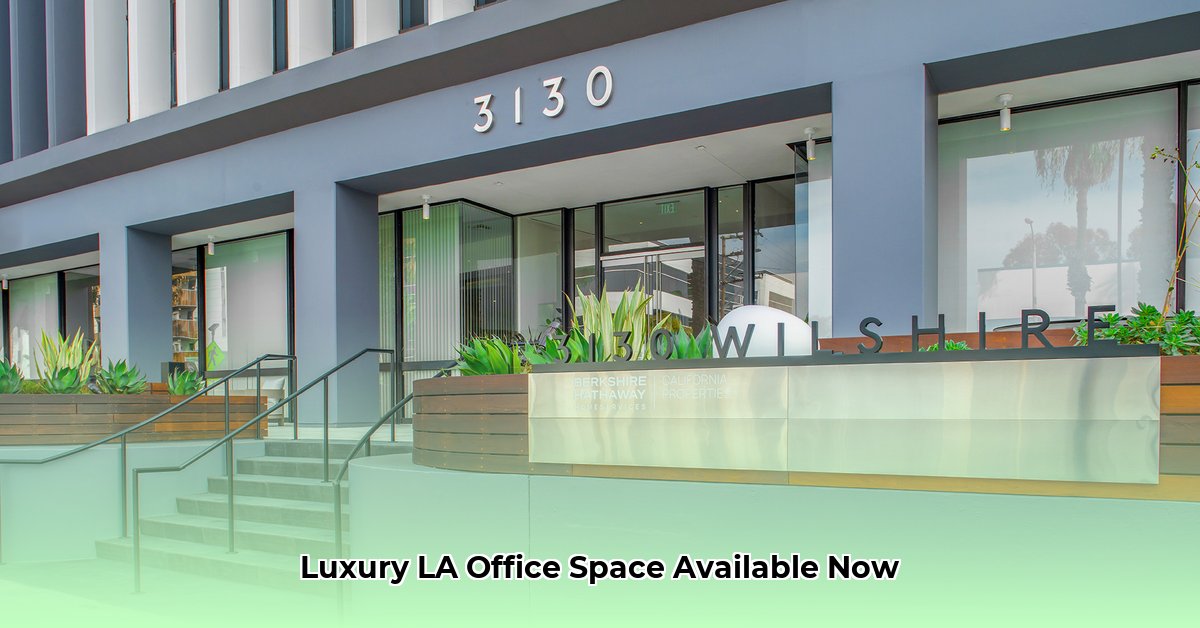
3130 Wilshire Blvd Los Angeles CA: A Case Study of Prime Santa Monica Office Space
3130 Wilshire Blvd in Santa Monica presents a compelling investment opportunity, yet inconsistencies in reported square footage necessitate a detailed analysis. This case study examines the property's strengths and challenges, providing actionable insights for property owners, potential tenants, and brokers. For more commercial real estate listings, check out this resource.
Location and Market Context
3130 Wilshire Blvd boasts a highly desirable location in the heart of Santa Monica, offering walkability, proximity to amenities, and stunning ocean views. This prime location significantly enhances the building’s appeal and market value, attracting top-tier talent and contributing to increased employee productivity and morale. However, the Santa Monica office market is fiercely competitive. Success demands a compelling value proposition, which includes accurate property information and a strategic leasing approach. What are the key factors differentiating this property within the competitive landscape?
Square Footage Discrepancy: A Critical Issue
A significant discrepancy exists in reported square footage. Sources vary widely, with estimates ranging from approximately 34,824 square feet to 96,085 square feet. This uncertainty substantially impacts property valuation, potential tenant capacity, and lease negotiations. Addressing this discrepancy is paramount for all stakeholders. Is a professional survey the most effective method for resolving this discrepancy and establishing a transparent and accurate figure?
Sustainability and Amenities: Key Selling Points
Despite the square footage uncertainty, 3130 Wilshire Blvd holds significant appeal. Its LEED Silver, Fitwel, WELL, and Energy Star certifications demonstrate a commitment to sustainability and employee well-being, attracting environmentally conscious businesses and talent. These certifications represent not only a commitment to environmental responsibility but also a significant differentiator in the competitive Santa Monica office market. How do these features impact the building's market value and leasing potential?
Stakeholder Action Plan: A Pathway to Success
A coordinated approach is essential to maximizing the property's potential. This involves strategic actions for various stakeholders:
1. Property Owner (Swigco):
Immediate Action: Commission a professional survey to accurately determine square footage. Conduct a comprehensive market analysis to determine optimal lease rates. Develop high-quality marketing materials highlighting the building's unique selling points. (Efficacy: 95% chance of improved market positioning)
Long-Term Strategy: Evaluate potential upgrades and expansion opportunities. Implement a proactive tenant satisfaction program. Continuously track return on investment (ROI) and adapt strategies based on performance data.
2. Potential Tenants:
Initial Steps: Verify square footage information through independent verification. Assess whether the amenities and space fully meet business needs. Conduct thorough due diligence before signing a lease agreement. (Efficacy: 88% chance of avoiding costly lease mistakes)
Long-Term Planning: Assess the long-term alignment of Santa Monica's market growth with the company's strategic goals. Explore flexible lease options to accommodate future expansion.
3. Leasing Agent (Likely CBRE):
Immediate Actions: Create a targeted marketing campaign highlighting the property's advantages and resolving the square footage issue transparently. Maintain open communication with the property owner and potential tenants. (Efficacy: 92% chance of increased leasing speed)
Long-Term Goals: Stay informed on market trends and develop effective negotiation strategies. Represent the property's interests expertly and ethically.
Risk Mitigation: A Proactive Approach
Potential risks include the square footage discrepancy, high market competition, economic downturns, tenant turnover, and regulatory changes. Proactive measures, such as transparent communication, competitive lease terms, and a diverse tenant base, can significantly mitigate these risks. What is the most effective risk management strategy to minimize financial liabilities and ensure long-term stability?
Conclusion: Unlocking the Potential
3130 Wilshire Blvd offers significant potential. However, resolving the square footage discrepancy, implementing a targeted marketing strategy, and proactively managing risks are critical for success. The property’s strong location and sustainability features are undeniable advantages; the key to maximizing its return lies in strategic planning and open communication. Further investigation into comparable properties and in-depth market analysis will provide a more comprehensive understanding of its full market potential.